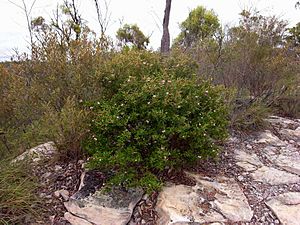Pink phebalium facts for kids
Quick facts for kids Pink phebalium |
|
|---|---|
 |
|
| Scientific classification | |
| Genus: |
Phebalium
|
| Species: |
nottii
|
| Synonyms | |
Phebalium nottii, often called pink phebalium, is a type of shrub. It grows only in eastern Australia. This plant has branches covered with shiny, silvery scales. Its leaves are shaped like long ovals. When it blooms, you'll see beautiful deep pink or purple flowers. A cool thing about its flowers is that their stamens (the parts that hold pollen) are all grouped to one side!
Contents
What Does Pink Phebalium Look Like?
Pink phebalium is a shrub that usually grows to be about 1 to 3 meters tall. That's like a tall person or a small tree! Its branches are covered with silvery or rusty-colored scales.
Leaves and Flowers
The leaves are thin and shaped like long ovals. They are about 2 to 5 centimeters long and 4 to 13 millimeters wide. The top of the leaf is smooth. The bottom of the leaf has silvery scales.
The flowers are pink to deep purple. They grow in small groups of up to six flowers. Each flower sits on a short stalk about 2 to 5 millimeters long. The cup-shaped part at the base of the flower, called the calyx, is covered with silvery or rust-colored scales.
The petals are narrow and shaped like an egg or a small spoon. They are about 8 to 12 millimeters long. The stamens, which are the parts that hold the bright yellow pollen, are special. They are all grouped to one side of the flower. Pink phebalium flowers in the spring.
How It Got Its Name
This plant was first officially described in 1867. A scientist named Ferdinand von Mueller gave it the name Eriostemon nottii.
Later, in 1899, two other scientists, Joseph Maiden and Ernst Betche, changed its name to Phebalium nottii. They published this new name in a science journal. The "nottii" part of its name honors a person named Dr. Nott from Gawler.
Where Does Pink Phebalium Grow?
Pink phebalium grows in forests where there is sandstone rock. You can find it in inland Queensland. It also grows in certain areas of New South Wales, like around Grafton and the Coonamble-Peak Hill regions.
See also
 In Spanish: Phebalium nottii para niños
In Spanish: Phebalium nottii para niños


